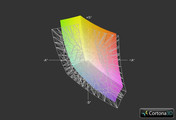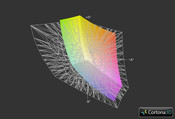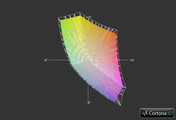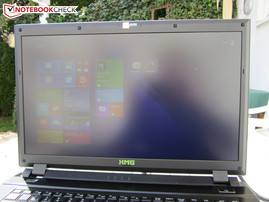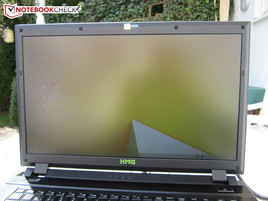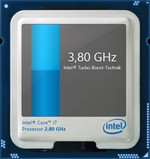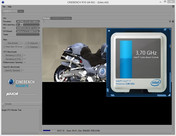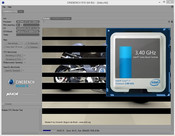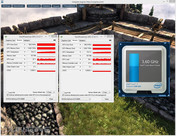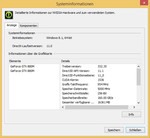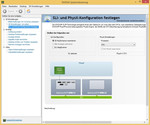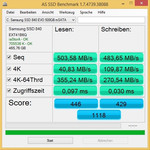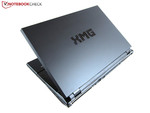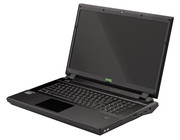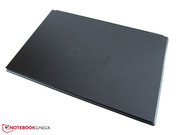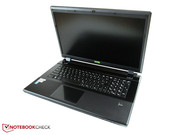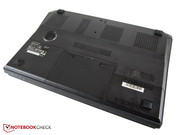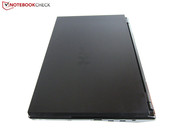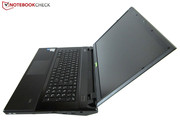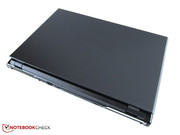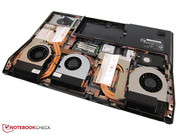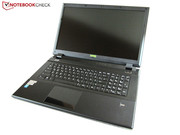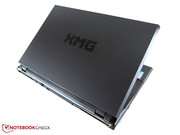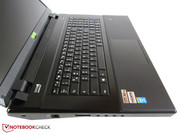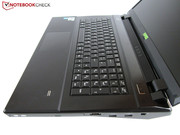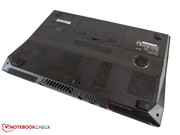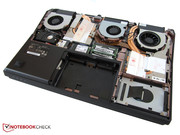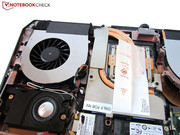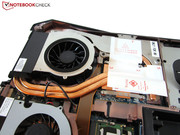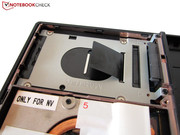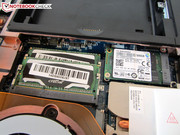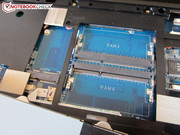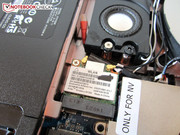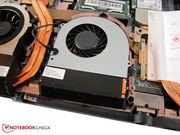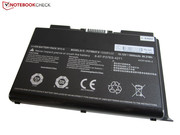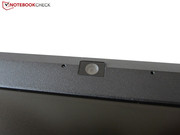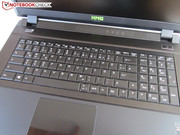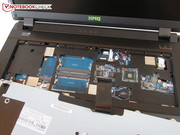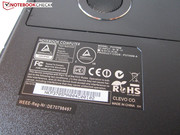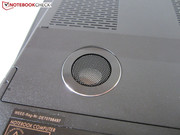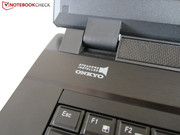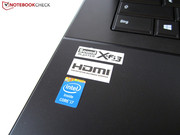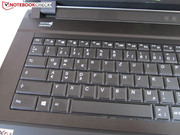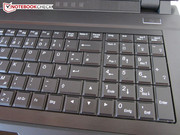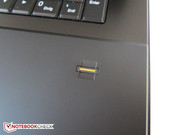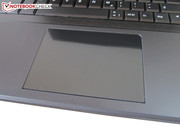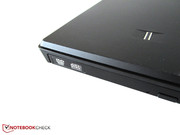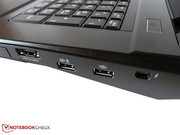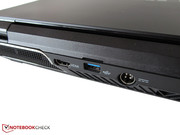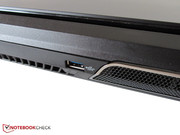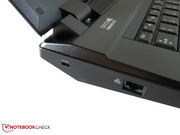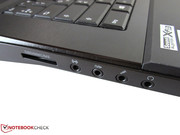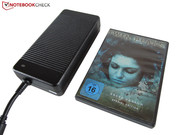Review Clevo P370SM-A (Schenker XMG P724) Barebones Notebook
For the original German review, see here.
The XMG P724 is definitely a high-end notebook. While most rivals can only be equipped with one or two hard drives as well as a single GPU solution, the Schenker device offers two mSATA slots, two 2.5-inch bays and SLI or CrossFire support, respectively. You can replace the standard Radeon R9 M290X with one GeForce GTX 880M (~25% faster) or a combination of two GTX 860M, R9 M290X or GTX 880M GPUs, if you are willing to pay the additional charges between 168 and 924 Euros (~$232 and $1277).
Besides the graphics cards, the configurator also offers options for the other components. The memory equipment, for instance, starts with 4 GB up to 32 GB (four slots), whereas the storage department includes HDDs, (mSATA) SSDs and hybrid drives. The optical drive is either a DVD or a Blu-ray burner. The list is completed by several wireless adaptors and processors. Schenker uses Intel’s Haswell generation, and almost every CPU is available, starting with an inexpensive dual-core like the Core i5-4200M all the way up to a prestigious high-end model like the Core i7-4940MX. Our review unit, for around 3,100 Euros (~$4285), is powered by the Core i7-4810MQ, which works perfectly with the SLI configuration and is still fairly affordable.
Only the display cannot be changed by the customer: The XMG P724 is always equipped with a matte Full HD panel. There are not many surprises in regard to the case, either. The Clevo barebones P370SM-A is nearly identical to the predecessor P370SM. Due to the slight changes (support for the latest GPUs, optimized sound), we will not have a closer look at the case, the connectivity and the input devices. Our review of the XMG P723 covers these sections extensively.
Display
It feels like the XMG P724 is the thousandth notebook with the Chi Mei N173HGE panel. The anti-reflective 17.3-inch model does leave a good impression at first. Besides the high luminance (~325 cd/m²), you can really see the high contrast; around 950:1 is not reached by most TN panels.
It is a similar situation with the black value. 0.37 cd/m² ensure a fairly accurate presentation of dark movie and game scenes. A higher value would mean that black areas could appear gray. A brightness distribution of 84% and 82% sRGB coverage are decent as well, even though there is still room for improvement.
| |||||||||||||||||||||||||
Brightness Distribution: 84 %
Contrast: 946:1 (Black: 0.37 cd/m²)
ΔE ColorChecker Calman: 10.69 | ∀{0.5-29.43 Ø4.77}
ΔE Greyscale Calman: 10.95 | ∀{0.09-98 Ø5}
56% AdobeRGB 1998 (Argyll 1.6.3 3D)
61.3% AdobeRGB 1998 (Argyll 3D)
83.7% sRGB (Argyll 3D)
60.4% Display P3 (Argyll 3D)
Gamma: 2.69
CCT: 13524 K
One noticeable drawback of the panel is the color presentation. According to the professional software CalMAN, both the color accuracy and the RGB balance show deviations, and you can see a tendency towards blue colors in many areas. You should not have very high requirements in regard to the gamma value and the grayscale presentation, either. The Gigabyte P34G shows a much better performance, but gamers will hardly notice these drawbacks, because the picture is subjectively very rich.
More annoying in our opinion are two unique characteristics of the Chi Mei N173HGE that we already observed in the past. Problem number one is the grainy finish. It almost appears as if someone put sand on the display surface, and some users may find this phenomenon annoying.
Another issue is that the Chi Mei N173HGE does not work really well with Nvidia products. There are no problems as long as the display is powered by the Intel chip, which is common for notebooks with switchable graphics. Using a GeForce GPU on the other hand can result in annoying stripes during darker passages (compare pictures of the XMG P723).
Apart from that, the 17-inch notebook does show good outdoor capabilities. The matte display surface and the high luminance ensure good readability, even on brighter days. The pictures below represent the worst-case scenario.
The Chi Mei N173HGE is reasonable in terms of viewing angle stability. Thanks to the small deviations with horizontal shifts, multiple persons can look at the display at the same time. The situation is much worse with vertical shifts, which is a typical restriction for the TN technology. You should get a notebook with an IPS panel if you are looking for a high picture quality (for example the Schenker M504).
Performance
Processor
Dual-core or quad-core, this is the question. However, the decision should not be too hard in the case of the XMG P724. Considering the current and the long-term performance, we would recommend a quad-core model from the i7-series.
Schenker equipped our review unit with the, to some, attractively priced Core i7-4810MQ to avoid performance limitations for the SLI combination. It has a clock of 2.8-3.8 GHz during 3D applications; six MB L3 cache is similar to the less expensive siblings, the Core i7-4702MQ (TDP of 37 Watts) and Core i7-4700MQ (TDP of 47 Watts).
One of the most important features of Intel processors is Hyperthreading. Due to four additional virtual cores, the quad-core can actually execute up to eight threads simultaneously. The current Haswell generation is manufactured in a 22 nm process.
Turbo Boost
Our screenshots show that the automatic overclocking works pretty well. 3.4-3.7 GHz during single-core load and 3.4 GHz during multi-core load are not the highest possible clocks for the Core i7-4810MQ, but the values are high enough in practice. CPU throttling is apparently no problem for the notebook. The processor still ran with at least 2.8 GHz after our one-hour stress test (FurMark + Prime95).
CPU Performance
All the benchmark results are on the expected level. 145 points in the single-core rendering test of Cinebench R15 are between the i7-4700MQ (132 points @ One K56-4N) and the i7-4910MQ (153 points @ Schenker XMG P704).
The multi-core performance of the XMP P724 is also very good. 680 points result in an advantage of 6% over the Core i7-4700MQ (640 points), but the Core i7-4910MQ is 2% ahead (700 points). The brand-new dual-core i5-4310M model is around 50% slower in this test (325 points @ Schenker M504).
| Cinebench R15 | |
| CPU Single 64Bit (sort by value) | |
| Core i7-4810MQ | |
| Core i5-4310M | |
| Core i7-4700MQ | |
| Core i7-4910MQ | |
| CPU Multi 64Bit (sort by value) | |
| Core i7-4810MQ | |
| Core i5-4310M | |
| Core i7-4700MQ | |
| Core i7-4910MQ | |
| Cinebench R11.5 | |
| CPU Single 64Bit (sort by value) | |
| Core i7-4810MQ | |
| Core i5-4310M | |
| Core i7-4700MQ | |
| Core i7-4910MQ | |
| CPU Multi 64Bit (sort by value) | |
| Core i7-4810MQ | |
| Core i5-4310M | |
| Core i7-4700MQ | |
| Core i7-4910MQ | |
Graphics
Even though the GeForce GTX 880M is still based on the Kepler architecture and not on the latest Maxwell architecture, the Nvidia chip is currently still the fastest notebook GPU. Similar to its predecessor, the GTX 780M, the high-end chip can use 1,536 CUDA cores and a 256-bit memory interface. The reason for the performance improvement is primarily the higher clocks. Nvidia raised the core clock from 823 to 954 MHz (up to 993 MHz via GPU Boost), but doubling the video memory (8 vs. 4 GB GDDR5) is unnecessary in our opinion.
To meet the premium demand, the manufacturer also offers its top version with two graphics cards. Nvidia’s dual-GPU technology competes with AMD’s counterpart CrossFire. It is also well known that both solutions have certain drawbacks. The additional heat requires a very powerful cooling solution, which often results in a very loud and big notebook. The battery runtimes are also limited due to the high power consumption.
Then there is also the issue with micro-stutters in low fps situations. The dual GPU solution is not very often in this critical area, but the game does not feel as smooth compared to a single GPU as soon as the frame rate drops below 40 fps. The cost-benefit factor, more precisely the additional performance per Euro, is – depending on the title – also limited.
If you choose such a dual-GPU solution, we would recommend an Nvidia setup because of the driver situation. AMD does not only support fewer titles, but the risk of bugs (for example graphic errors) is also bigger.
GPU Performance
The GeForce GTX 880M SLI can take the lead in most benchmarks due to the massive performance. 11,926 points in the 3DMark 2013 Fire Strike test is the best result we determined so far. Neither the GTX 780M SLI (10,091 points @ Alienware 18) nor a CrossFire setup with two Radeon R9 M290X GPUs (10,551 points @ Notebookguru Earth V) can keep up. A single GTX 880M falls behind by around 50% (6,095 points @ Schenker XMG P704).
We can see a similar result in the Unigine Heaven 3.0 benchmark; the XMG P724 manages a gigantic 145.9 fps with 1920x1080 pixels and normal Tessellation. The GTX 780M SLI follows in second place with 132.8 fps (-9%) and the significantly cheaper Radeon HD 8970M CF is third with 123.0 fps (-16% @ One K73-3S). One single GTX 880M levels off at around 81 fps (-44%).
| Unigine Heaven 3.0 - 1920x1080 DX 11, Normal Tessellation, High Shaders AA:Off AF:Off (sort by value) | |
| GeForce GTX 880M SLI (332.35) | |
| GeForce GTX 780M SLI (326.45) | |
| Radeon R9 M290X CF (13.152.1.2100) | |
| GeForce GTX 880M (332.35) | |
| 3DMark - 1920x1080 Fire Strike Graphics (sort by value) | |
| GeForce GTX 880M SLI (332.35) | |
| GeForce GTX 780M SLI (326.45) | |
| Radeon R9 M290X CF (13.152.1.2100) | |
| GeForce GTX 880M (332.35) | |
| 3DMark 11 - 1280x720 Performance GPU (sort by value) | |
| GeForce GTX 880M SLI (332.35) | |
| GeForce GTX 780M SLI (326.45) | |
| Radeon R9 M290X CF (13.152.1.2100) | |
| GeForce GTX 880M (332.35) | |
| 3DMark Vantage - 1280x1024 P GPU no PhysX (sort by value) | |
| GeForce GTX 880M SLI (332.35) | |
| GeForce GTX 780M SLI (326.45) | |
| Radeon R9 M290X CF (13.152.1.2100) | |
| GeForce GTX 880M (332.35) | |
| 3DMark Vantage P Result | 36366 points | |
| 3DMark 11 Performance | 12756 points | |
| 3DMark Ice Storm Standard Score | 139700 points | |
| 3DMark Cloud Gate Standard Score | 23794 points | |
| 3DMark Fire Strike Score | 9168 points | |
Help | ||
Storage Solution
Current systems heavily benefit from a Solid-State Drive. Windows feels much more responsive with the fast flash memory compared to a conventional hard drive.
Samsung’s SSD 840 EVO is especially fast, in this case the 500 GB version. AS SSD determines excellent results for the mSATA drive, despite the small dimensions. A sequential read performance of 504 MB/s is just as respectable as 484 MB/s for sequential writing. Especially the latter is usually not reached by many SSDs. Access times and the performance with small files do not cause any criticism, either.
Sufficient storage for our review unit is provided by the HGST Travelstar 5K1500 with a capacity of 1.5 TB. Transfer rates (read/write) of around 110 MB/s (CrystalDiskMark) are not the fastest we have ever seen, but the 2.5-inch drive only runs at 5,400 revolutions per minute.
System Performance
The balanced hardware equipment is especially apparent in the system benchmarks. A PCMark 7 score of 6,018 points is slightly ahead of the One K73-4N, which was configured with a Core i7-4800MQ, a GeForce GTX 870M and a 2.5-inch Samsung SSD 840 (6,017 points). PCMark results really depend on the storage solution, so supposedly slower notebooks like the MSI GS70 Stealth (Core i7-4700HQ, GeForce GTX 765M, SSD RAID) can get a higher score.
| PCMark 7 Score | 6018 points | |
| PCMark 8 Home Score Accelerated v2 | 4275 points | |
| PCMark 8 Creative Score Accelerated v2 | 4767 points | |
| PCMark 8 Work Score Accelerated v2 | 4799 points | |
Help | ||
Gaming Performance
The XMG P724 is one of the few notebooks that is actually powerful enough for smooth frame rates with maximum details, 1920x1080 pixels and high anti-aliasing settings in almost every title. Our ultra-setting resulted in more than 50 fps in 15 of 16 games. Only the very CPU demanding and not very well optimized X-Plane 10 showed dropped frames.
The impact of the second GTX 880M differs from game to game. While the performance was not improved at all in F1 2013, we could almost see twice the performance in Far Cry 3, Tomb Raider and Battlefield 4. Otherwise, we determined a performance advantage between 10% (Dota 2) and 60% (Thief, Call of Duty: Ghosts, GRID 2, BioShock: Infinite & Crysis 3). The SLI system is almost 40% ahead of a single GTX 880M on average. Is a performance advantage of 40% really worth an additional charge of 650 Euros (~$899)? That can be discussed.
| low | med. | high | ultra | |
|---|---|---|---|---|
| Guild Wars 2 (2012) | 115.4 | 61 | 56 | |
| Hitman: Absolution (2012) | 67.2 | 62.2 | 54.4 | 53.1 |
| Far Cry 3 (2012) | 113.6 | 103.2 | 85.6 | 63.6 |
| Crysis 3 (2013) | 128.3 | 113.6 | 93.2 | 52.3 |
| Tomb Raider (2013) | 426.6 | 367.4 | 296 | 141.8 |
| BioShock Infinite (2013) | 222.6 | 198.1 | 181.4 | 104 |
| Metro: Last Light (2013) | 112.8 | 107.6 | 90.2 | 61.8 |
| GRID 2 (2013) | 211.6 | 152.2 | 141.4 | 119.1 |
| Dota 2 (2013) | 117.7 | 116.1 | 115.8 | |
| Saints Row IV (2013) | 85.4 | 72.4 | 69.3 | 67.4 |
| F1 2013 (2013) | 117 | 117 | 114 | 95 |
| Battlefield 4 (2013) | 194.4 | 179.3 | 155.8 | 84.5 |
| Call of Duty: Ghosts (2013) | 97.2 | 91.4 | 75.1 | 71.2 |
| X-Plane 10.25 (2013) | 115.6 | 54.2 | 27.9 | 22.3 |
| Thief (2014) | 76.2 | 73.3 | 70 | 63.6 |
| Titanfall (2014) | 60 | 60 | 60 | 59.9 |
However, the improvement is bigger with less powerful GPU systems like the GeForce GT 755M SLI (Lenovo IdeaPad Y510p) or the GeForce GTX 765M SLI (Aorus X7) because they are not as quickly limited by the CPU. You can actually notice that the Core i7-4810MQ is the limiting factor in some games, and not the GTX 880M SLI. This is the case in Guild Wars 2, Saints Row IV as well as Hitman: Absolution, and even the GTX 780M SLI is slightly ahead in these titles. Speaking of the GTX 780M SLI: The old high-end combination is around 10% behind the GTX 880M SLI; the almost 550 Euros (~$760) less expensive Radeon R9 M290X CF falls behind by around 20%.
Excellent benchmark scores or not: We still believe that even passionate gamers should be better off with a single GPU solution, and the saved money can be invested into the next notebook.
| Titanfall - 1920x1080 (Very) High AA:4xMS AF:16x (sort by value) | |
| GeForce GTX 880M SLI (332.35) | |
| GeForce GTX 880M (332.35) | |
| Thief - 1920x1080 Very High Preset AA:FXAA & High SS AF:8x (sort by value) | |
| GeForce GTX 880M SLI (332.35) | |
| Radeon R9 M290X CF (13.152.1.2100) | |
| GeForce GTX 880M (332.35) | |
| X-Plane 10.25 - 1920x1080 ultra (fps_test=4) test_flight_c4 (sort by value) | |
| GeForce GTX 880M SLI (332.35) | |
| Radeon R9 M290X CF (13.152.1.2100) | |
| GeForce GTX 880M (332.35) | |
| Call of Duty: Ghosts - 1920x1080 Extra / High / HBAO+ / No dynamic fur AA:4x MS (sort by value) | |
| GeForce GTX 880M SLI (332.35) | |
| Radeon R9 M290X CF (13.152.1.2100) | |
| GeForce GTX 880M (332.35) | |
| Battlefield 4 - 1920x1080 Ultra Preset AA:4x MS (sort by value) | |
| GeForce GTX 880M SLI (332.35) | |
| Radeon R9 M290X CF (13.152.1.2100) | |
| GeForce GTX 880M (332.35) | |
| F1 2013 - 1920x1080 Ultra Preset AA:4x MS (sort by value) | |
| GeForce GTX 880M SLI (332.35) | |
| Radeon R9 M290X CF (13.152.1.2100) | |
| GeForce GTX 880M (332.35) | |
| Saints Row IV - 1920x1080 Ultra Preset AA:8x MS AF:16x (sort by value) | |
| GeForce GTX 880M SLI (332.35) | |
| GeForce GTX 780M SLI (326.45) | |
| Radeon R9 M290X CF (13.152.1.2100) | |
| GeForce GTX 880M (332.35) | |
| Dota 2 - 1920x1080 High / On, Render Quality: 100 % (sort by value) | |
| GeForce GTX 880M SLI (332.35) | |
| GeForce GTX 780M SLI (326.45) | |
| Radeon R9 M290X CF (13.152.1.2100) | |
| GeForce GTX 880M (332.35) | |
| GRID 2 - 1920x1080 Ultra Preset AA:4xMS (sort by value) | |
| GeForce GTX 880M SLI (332.35) | |
| GeForce GTX 780M SLI (326.45) | |
| Radeon R9 M290X CF (13.152.1.2100) | |
| GeForce GTX 880M (332.35) | |
| Metro: Last Light - 1920x1080 Very High (DX11) AF:16x (sort by value) | |
| GeForce GTX 880M SLI (332.35) | |
| GeForce GTX 780M SLI (326.45) | |
| Radeon R9 M290X CF (13.152.1.2100) | |
| GeForce GTX 880M (332.35) | |
| BioShock Infinite - 1920x1080 Ultra Preset, DX11 (DDOF) (sort by value) | |
| GeForce GTX 880M SLI (332.35) | |
| GeForce GTX 780M SLI (326.45) | |
| Radeon R9 M290X CF (13.152.1.2100) | |
| GeForce GTX 880M (332.35) | |
| Tomb Raider - 1920x1080 Ultra Preset AA:FX AF:16x (sort by value) | |
| GeForce GTX 880M SLI (332.35) | |
| GeForce GTX 780M SLI (326.45) | |
| Radeon R9 M290X CF (13.152.1.2100) | |
| GeForce GTX 880M (332.35) | |
| Crysis 3 - 1920x1080 Very High Preset AA:2xSM AF:16x (sort by value) | |
| GeForce GTX 880M SLI (332.35) | |
| GeForce GTX 780M SLI (326.45) | |
| Radeon R9 M290X CF (13.152.1.2100) | |
| GeForce GTX 880M (332.35) | |
| Far Cry 3 - 1920x1080 DX11 Ultra Preset (HDAO, Enhanced Alpha To Coverage) AA:4x MS (sort by value) | |
| GeForce GTX 880M SLI (332.35) | |
| GeForce GTX 780M SLI (326.45) | |
| Radeon R9 M290X CF (13.152.1.2100) | |
| GeForce GTX 880M (332.35) | |
| Hitman: Absolution - 1920x1080 Ultra Preset AA:4xMS AF:16x (sort by value) | |
| GeForce GTX 880M SLI (332.35) | |
| GeForce GTX 780M SLI (326.45) | |
| Radeon R9 M290X CF (13.152.1.2100) | |
| GeForce GTX 880M (332.35) | |
| Guild Wars 2 - 1920x1080 All Maximum / On AA:FX (sort by value) | |
| GeForce GTX 880M SLI (332.35) | |
| GeForce GTX 780M SLI (326.45) | |
| Radeon R9 M290X CF (13.152.1.2100) | |
| GeForce GTX 880M (332.35) | |
Emissions
System Noise
Unfortunate: Nothing really changed in terms of noise development. 40 dB(A) during idle is definitely too high, some gaming notebooks like the Asus G750JH only reach this value under load. The temporary rpm increase is also annoying. It does not matter if you edit a text document, browse the web or watch a video: You will have to live with up to 48 dB(A).
It is not often that we see such bad fan control, which only focuses on the temperatures and completely ignores the noise development. 48-51 dB(A) during 3D applications and up to 55 dB(A) under maximum load are also not acceptable for every user.
Please do not misunderstand us: We know that gaming notebooks have to dissipate the heat. However, you can expect better from such a big cooling solution inside the P370SM-A – especially with light workloads. Other manufacturers do a better job (just compare the system noise of the Alienware 18).
Noise level
| Idle |
| 40 / 40.4 / 48.4 dB(A) |
| DVD |
| 41.4 / dB(A) |
| Load |
| 50.2 / 55.4 dB(A) |
 | ||
30 dB silent 40 dB(A) audible 50 dB(A) loud |
||
min: | ||
Temperature
The temperatures leave a mixed impression. A positive aspect is the reasonably cool chassis surfaces that stay comfortable even under maximum load. Up to 43 °C (109.4 °F) indicate a moderate temperature development of the case. It is especially cool during idle; we just measured 25-31 °C (77-87.8 °F) after an idle period of two hours.
The hardware on the other hand gets much hotter. Both GPUs climbed to around 90 °C (194 °F) under maximum load – despite a core throttling of almost 50%. Around 95 °C (203 °F) for the CPU is also quite a lot, although the notebook is usually not stressed that much during gaming.
(±) The maximum temperature on the upper side is 42 °C / 108 F, compared to the average of 40.4 °C / 105 F, ranging from 21.2 to 68.8 °C for the class Gaming.
(±) The bottom heats up to a maximum of 42.8 °C / 109 F, compared to the average of 43.3 °C / 110 F
(+) In idle usage, the average temperature for the upper side is 28 °C / 82 F, compared to the device average of 33.9 °C / 93 F.
(+) The palmrests and touchpad are reaching skin temperature as a maximum (33.4 °C / 92.1 F) and are therefore not hot.
(-) The average temperature of the palmrest area of similar devices was 28.8 °C / 83.8 F (-4.6 °C / -8.3 F).
Speakers
Even though the case manufacturer said they improved the sound system, the result still pretty much reminds us of the P370SM barebones. The sound quality is above average for a notebook, but it cannot quite reach the quality of the MSI GT70, which sounds much better.
The Onkyo speakers tend to distort with higher volumes. Overall, the sound could be a bit more precise, especially since the Sound Blaster software does add some background noise to audio contents. You should, however, keep the feature activated.
Energy Management
Power Consumption
Because of the missing Optimus technology, you will have to live with very high power consumption. It is similar to the Notebookguru Earth V during idle, which was reviewed with a Core i7-4700MQ and a Radeon R9 M290X CF. 37-47 Watts during idle is enormous, even for a gaming notebook. This value would probably drop below 30 Watts with switchable graphics.
We were quite surprised by the behavior during 3DMark 06. The consumption fluctuated quite a lot, more precisely between 126 and 176 Watts with an average of 155 Watts, which is similar to the Guru Earth V. We determined a bigger difference under maximum load. The XMG P724 uses around 40% more energy with 326 vs. 232 Watts.
| Off / Standby | |
| Idle | |
| Load |
|
Key:
min: | |
Battery Runtime
The notebook cannot really benefit from the heavy 8-cell battery (450 grams; ~1 pound). The Battery Eater Reader's test only determined a little more than 2.5 hours (0% brightness, maximum energy-saving), and the Classic test (100% brightness, minimum energy-saving) around 1.5 hours.
Note: All benchmarks were performed with activated SLI.
Verdict
Perfect gaming fun or overpriced hardware? Opinions about desktop replacements like the XMG P724 differ quite a lot. Objectively, we can say that Schenker offers an unbelievably powerful and well-equipped high-end package.
The 17-inch notebook does not have an IPS panel, but the Full HD matte display still gets a good rating. Besides the picture quality, we also like the sound. The chassis on the other hand has advantages and drawbacks. The P370SM-A barebones from Clevo is very big and heavy, but also offers many ports, cool surfaces and an illuminated keyboard in return. Maintainability and upgradability are even on a reference-level. Only the glossy touchpad does not really fit into the overall package.
There is not much left to say about the performance. Nvidia's GeForce GTX 880M (SLI) is the fastest hardware until the launch of the Maxwell counterpart. However, the dual-GPU solution has a negative impact on the mobility, the power consumption and the noise development. Whether at idle or running 3D applications, the fans are always audible. GPU throttling under maximum load and stripes on the display (depending on the background) are not perfect, either.
However, there are not many alternatives for ambitious gamers who do not want to make any compromises.



